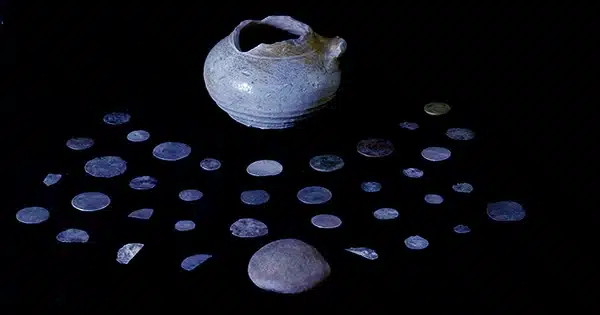Archaeologists believe coins discovered under a fireplace were hidden there by a victim of the historic Glencoe Massacre.
In February 1692, soldiers were sent to raid Clan MacDonald of Glencoe, killing over 40 members of the clan.
A student discovered the money at the location of a residence associated with the clan’s chief.
Lucy Ankers made the discovery while on her first excavation.
The 36 coins were placed beneath a hearth stone slab in the fireplace, inside a container with a little round rock as a lid.
The discovery was uncovered in August during an excavation undertaken by archaeologists from the University of Glasgow at the site of the ruined house.

The land belonged to clan leader Alasdair Ruadh “MacIain” MacDonald of Glencoe.
He was one of the estimated 38 victims of the atrocity.
“As a first dig experience, Glencoe was amazing,” Ms Ankers added.
“The two weeks I spent digging solidified that I want to pursue a career within archaeology.”
She went on to say: “I wasn’t expecting such an exciting find as one of my firsts, and I don’t think I will ever beat the feeling of seeing the coins peeking out of the dirt in the pot.”
The MacDonalds were persecuted for their support for the exiled King James VII of Scotland and II of England.
The clan supported the Stuart dynasty’s return to the British throne and took part in the first Jacobite Rising in 1689.
According to historians, they were late in taking an oath of allegiance to the Protestant King William III and were labeled as rebels by the Secretary of Scotland, Sir John Dalrymple.
About 120 soldiers from the Earl of Argyll’s Regiment of Foot landed in Glencoe from Invergarry in late January 1692, led by Capt Robert Campbell of Glen Lyon.
The troops were billeted with clan members before turning against them on February 13th.
Some people attempted to flee in a snowstorm to adjacent glens, notably Gleann Leac-na-guide, where the coin hoard was discovered.
The University of Glasgow has proposed several theories as to why the money could be linked to the killing.
Because none of the coins were struck after the 1680s, archaeologists believe they were most likely buried under the fireplace for safekeeping either before or during the killings.
The researchers also stated that whoever buried the coins did not return them, potentially implying that they were among the massacre victims.
The coins date from the late 1500s to the 1680s and contain pieces from Elizabeth I’s, James VI and I’s, Charles I, the Cromwellian Commonwealth, and Charles II’s reigns.
There were additional coins from France and the Spanish Netherlands, as well as one that appeared to be from the Papal States.
“These exciting finds give us a rare glimpse of a single, dramatic event,” said Dr Michael Given, co-director of the Glencoe archaeological project.
“This appears to be a typical rural house, but it has a grand fireplace, impressive floor slabs, and exotic pottery imported from the Netherlands and Germany.”
“And they’ve gathered an incredible collection of coins in a small pot and buried them beneath the fireplace.”
“It’s a real privilege, as archaeologists, to hold in our hands these objects that were so much part of people’s lives in the past.”
“The excavation of MacIain’s Summerhouse allows us to better understand the importance of these uplands to local elites,” said University of Glasgow excavations director Edward Stewart.
“The size of this structure, as well as the wealth of artifacts discovered within, indicate that this was a place where the MacDonald chiefs could entertain with feasting, gambling, hunting, and libations.”
“The discovery of this coin hoard within the structure adds a thrilling new dimension to this story.”
“However, ordinary and everyday finds within this structure such as spindle whorls for making a thread, a pitchfork, and a dress pin, speak to the everyday lives of those who lived here, worked the land, and minded the cattle.”















